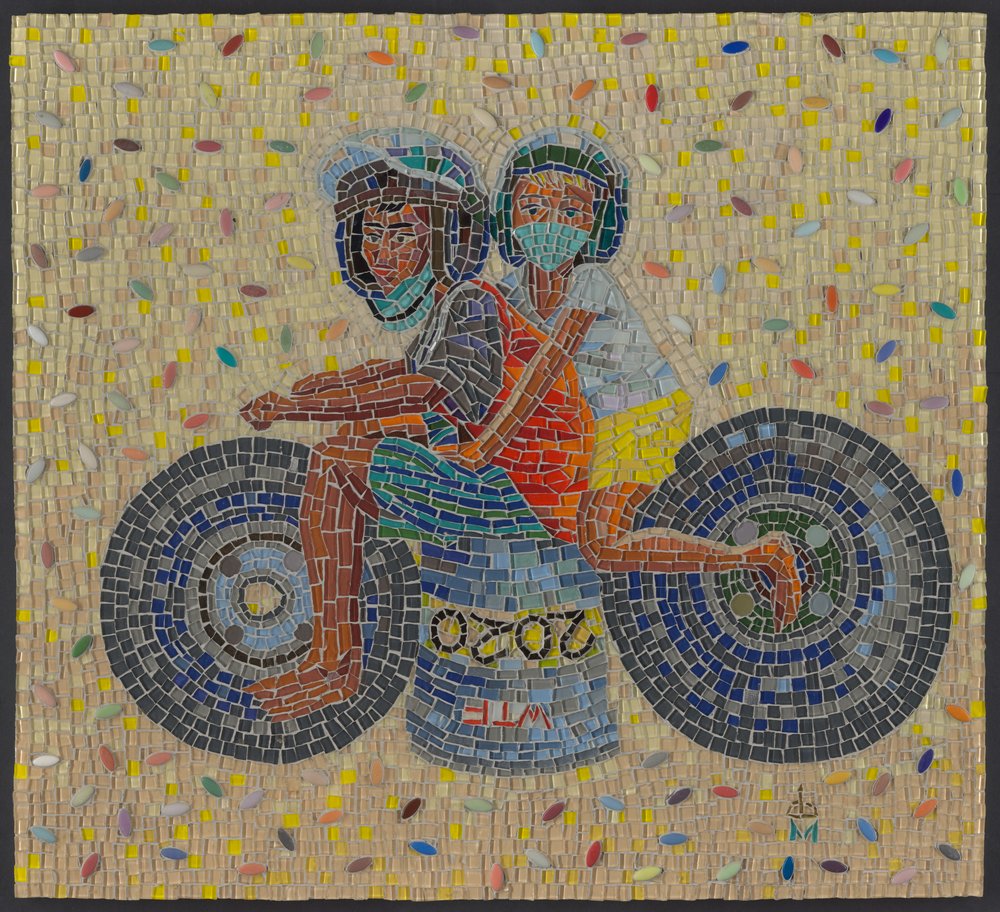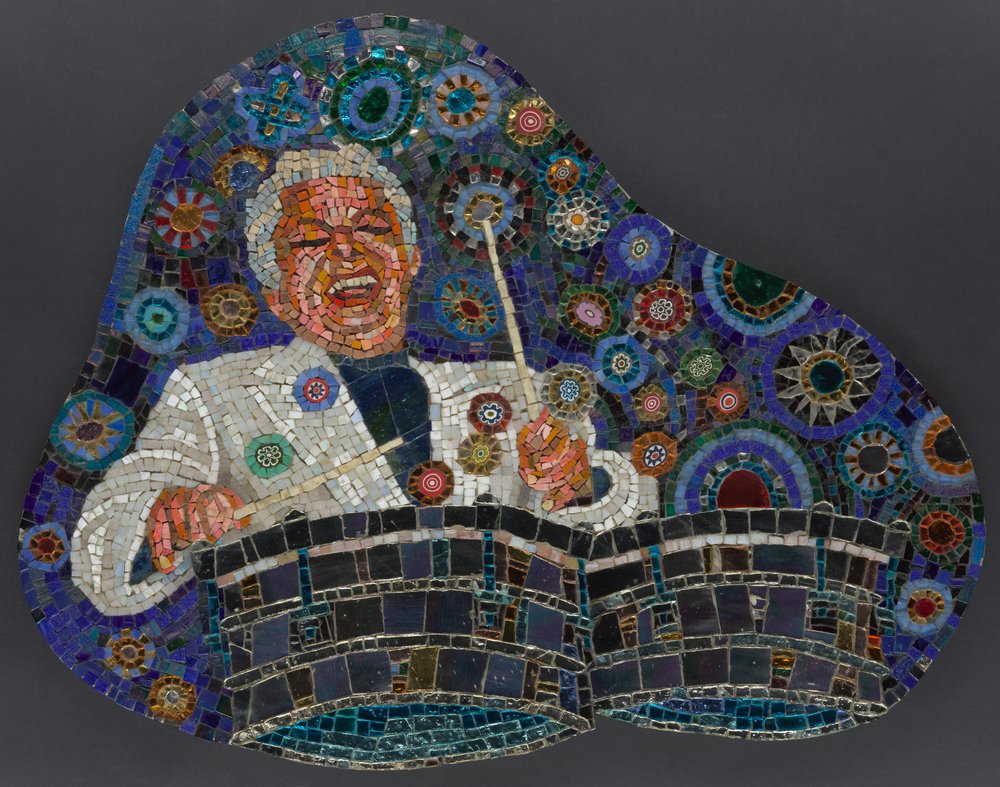Bronx artist Manny Vega on his new show: 'I’m not chasing an art scene'
Dec. 19, 2023, 12:01 p.m.
“Byzantine Bembé, New York by Manny Vega” is on now through December 2024 at the Museum of the City of New York.

You’ve probably seen Manny Vega’s work – you just might not know it.
The Bronx-born artist has created murals and mosaics that decorate the city: from storefronts in East Harlem to the subway stop at 110th Street and Lexington Avenue.
This year, he’s the first-ever artist in residence at the Museum of the City of New York.

The museum is showing some of Vega’s work in a special exhibit titled “Byzantine Bembé, New York by Manny Vega,” which draws on El Barrio's culture and history as well as Vega’s Nuyorican roots.
Vega and the curator of his show, Monxo Lopez, spoke to Alison Stewart on a recent episode of “All of It.”
You can listen to their whole conversation here; an edited version is below.
Alison Stewart: Manny, what does it mean to you to be selected as the first-ever artist in residence?
Manny Vega: I'm extremely honored and not only because of the prestige of this museum, but they're saluting me for being me. You know, in my “Manny-ness.”
And that's a good message to send out to the art world – that I'm not chasing an art scene, that I'm just busy being me, being a happy Buddha in the streets of New York, and that New York has always been full of inspiration.
What's your process for selecting materials when you begin a mosaic?
Vega: We as Puerto Ricans, especially in New York, we have a culture of hoarding.
Repurposing!
Vega: Repurposing, of living with these clutters, because somehow we know that it's purposeful. I live amassing art supplies and having, literally, a conversation with the materials, where the actual materials themselves suggest to me what the next project is gonna be.
I work with synergy. “Synergy” meaning I work with the enthusiasm of the last project that I created. I mainly segue to the next project, And I live that way, and that's why I've been so prolific. I don't look back.
Monxo and his curators who came to my apartment, they were intrigued with that. And, you know, they made me stop for a second to turn around and look at this mountain of work that I've been amassing throughout the years. Because, again, I don't create work to be a part of an art scene. I am truly entertained by creating work.
You know? It's not hard work. I call it “hard fun.” I'm just a big nene. I'm just a big kid.
My favorite catchphrase to people is “monkey see, monkey do.” Why? Because I'm self-taught. I'm a good observer.
I'm a good listener. I'm continuously a student. And New York is the perpetual university.
For sure.
Vega: It all depends on how attentive you are. You could be a writer, a dancer. You could be a painter and be perpetually entertained by what's in front of you. It all depends on what you're paying attention to.
You can absorb so much in the city.
Vega: The other thing that I want to emphasize is the urgency of me being Manny Vega now because it's all about reconfiguring this label called “America.”
That New York and El Barrio is a huge contribution to the conversation of homeland and America. And so I'm doing this with a lot of love. And a lot of just pure intention – good intention– because we're formulating who we are.
We have to remember that we're only 500 years old compared to the rest of the world. We're still a work in progress.
And so this is where I see all this polarity and all the difficulty that we're having as just part of our growth process, but always with a good intention of developing this country to be what it could be.
If you lead with heart, you can have any conversation, I really believe.
Vega: Well, we are bilingual. We're trilingual. We live under each other's noises. We are a living diaspora. I was born and raised in the city, in the projects. And so my relatives are my neighbors. They continue to be. I live celebrating – not only New York – but now everywhere in the world that I go. But New York has always been the source of that.
We have a text from a listener: Could Manny please speak to the term “bembé”?
Vega: OK. Bembé comes from our diaspora existence. It's literally like an African word, and it means “a celebration connected to your guardian entities, your spirits and your ancestors.”
The Mexicans, for example, have the Day of the Dead. They have a big feast in the cemetery. And it's the same thing with Afro-diaspora communities, where we have ceremonies where we're specifically creating a space for not only our ancestors, but for the guardian spirits that protect us.
Monxo Lopez: Bembé is a party also. When in the Puerto Rican, Cuban or Dominican community, they say, “I'm going to that bembé,” or, “Did you get to Manny's party?” “I got there late, but there was a bembé already.” It's a party.
Vega: It's a spiritual hipster term because, you know, spirit needs to be hip as well. Especially in New York. But there are other themes besides the three that are very prominent in my work. And the principal one that I always gravitate to is … You know, I'm a Puerto Rican male from the streets of the Bronx – very edgy, very New York story. But my contact, especially with my mother and the Brazilian community, has made me a champion of the feminine divine. Of reminding women of their power, of balancing this country.
By reminding women to step up into their power and to govern, and to contribute so we are healthier as a people, as a nation.
You mentioned it earlier, your spirituality and the importance of it and your faith to you. How does your spirituality motivate your work?
Vega: I realized that I've been doing this so long that I'm just a creature of habit. But I'm very brave about depicting these images that people are reluctant to depict. Again, celebrating women, celebrating spirit, because, you know, we're Americans. We want to be pragmatic.
I have to remind everybody that for me, two plus two is still four. Okay? My spiritual practice is actually very, very grounded in reality.
I demand reality from everybody, and I demand justice from everybody, because it's what I provide. Respect, dignity, morale, ethics, back to the simple basics. That, to me, is spiritual practice: to be polite every day, to say good morning.
That's spiritual practice. I'm actually becoming a nerd about it. And it's a good time to do that.
I can't ask people to do that. I have to be the first one to do that. Because when I'm doing that for people and with people, I'm setting the example, especially to children.
I'm creating this movement with young folks – not only to recognize their capacity – but to recognize the power of grace, of gratitude, of self-respect.
I want to put those configurations in front of them right away, and trust, because that's what people need is that invitation.
And so I'm having this wonderful relationship with this museum and making them the perpetual invitation, especially to El Barrio, but the entire city and the country benefit.
Monxo, so many of us have seen Manny's work in public spaces. What's unique about seeing it in a museum setting?
Lopez: So we worked with a firm of Puerto Rican designers from Marvel Architects. They went to Manny's apartment so that we could sort of reproduce the experience of his brain, and his living quarters in the gallery, where the show is happening – because trying to translate it or to showcase the work in your usual white box wasn't gonna work.
And so the gallery itself is full of colors, which Manny selected, and has a feeling of being a workshop. And so when people go there, they need to understand that it's going to feel a little bit like Manny's apartment.
And so that's what we were going after, because his work is very contextual. It’s either on the street or it's very intimate. It's part of a meditative practice.
Byzantine Bembé, New York by Manny Vega is on now through December of next year at the Museum of the City of New York.
Jamie Bernstein on her parents’ love story in Bradley Cooper’s 'Maestro' Was Y2K era the best for films? A new Metrograph NY series makes the case. I tried it: NYC's hottest (but potentially risky) new manicure